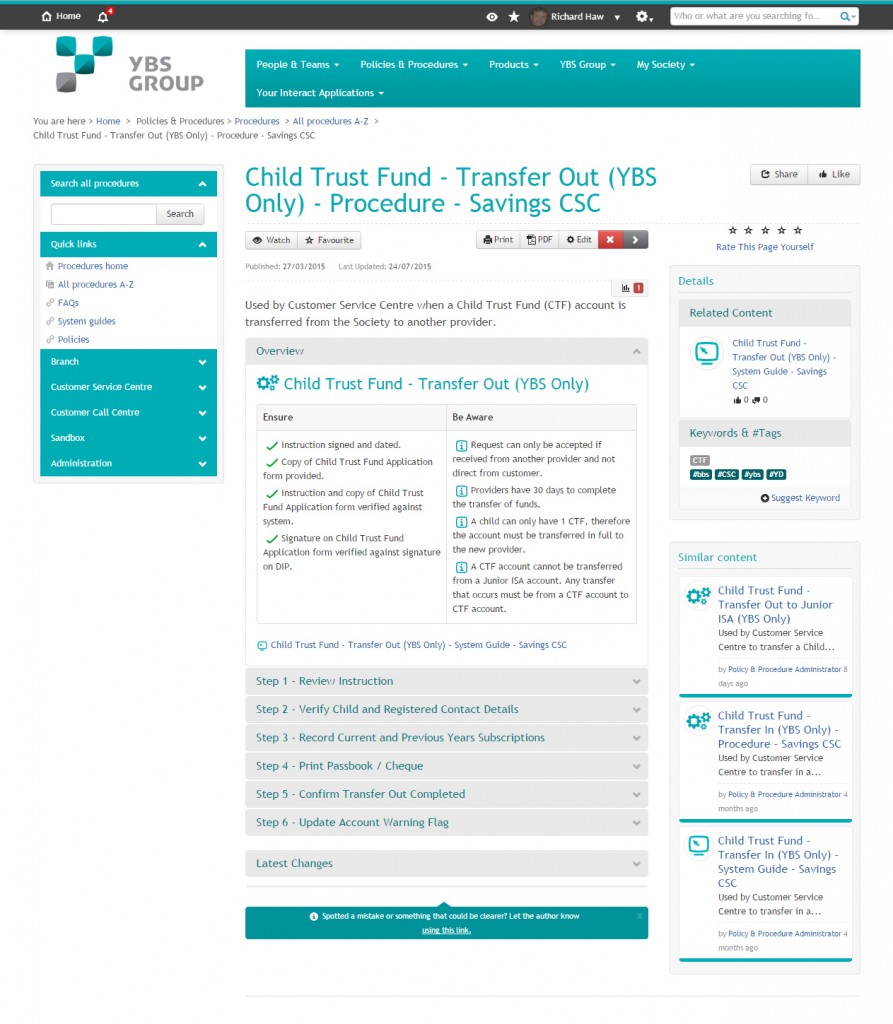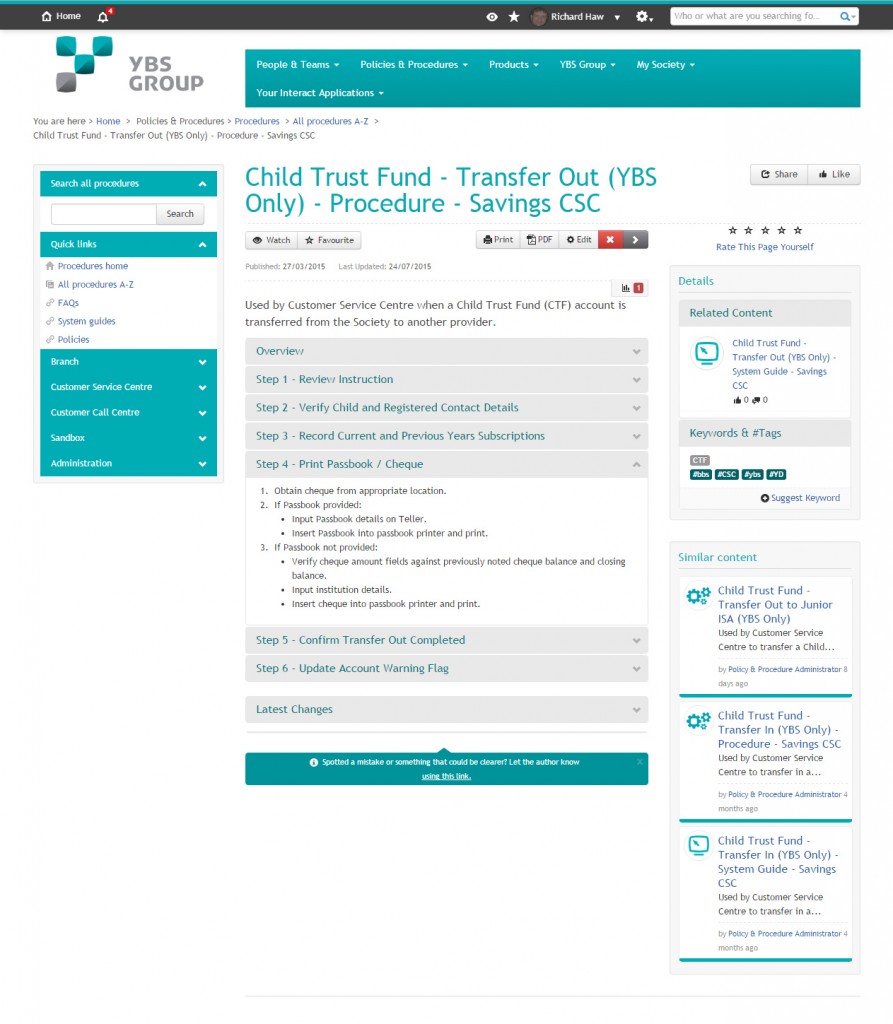YBS Group: Engaging employees by simplifying document management
‘Everything should be as simple as possible, but no simpler.’ So said Albert Einstein.
While we wouldn’t be so bold as to assume the good doctor necessarily had the Yorkshire Building Society (YBS) Group at the forefront of his mind with this particular declaration, we’re pretty certain it’s about as apt as you can get when it comes to describing our new intranet’s policies and procedures section.
Thanks to a flurry of successful mergers and acquisitions over the last seven years, we’re now the second largest building society in the UK, employing more than 4,500 people across branches and offices the length and breadth of the country.
But, as a business, our forward-facing attitude was being held back by an intranet that ran on a patchwork of antiquated software – some of it literally from the last century – showcasing an assortment of styles, layouts and functionality as you flicked from one page to another.
As our influence across the financial sector grew, so did our need for a modern, dynamic replacement site.
To be fair, in the decade or so that YBS has been discussing the need for a replacement intranet, it was hard to find any dissenters among the ranks. But having historically always been presented as a revolutionary communications tool, there always seemed to be another project more pressing, worthy or simply legally required for the business to complete.
Behind the scenes, each building society we merged with – Barnsley, Chelsea and Norwich & Peterborough – brought with it an additional set of policies, procedures and terms. Managing this bank of information grew increasingly unwieldy, with a sticking plaster approach presenting itself in a series of complex Excel spreadsheets and painstaking cut and paste processes.
Documents were lengthy and difficult to navigate for users, with a ‘one size fits all approach’ of providing excessively granular detail to cater for new starters, but leaving long serving colleagues frustrated when all they wanted was an at a glance checklist.
The document format was directly impacting the standard of service frontline colleagues could provide, often having to leave customers waiting while they laboriously scrolled through lengthy PDF documents to ‘quickly check’ the right process was being followed. In practice, many colleagues found it easier to simply phone a friend for guidance, which wasted time and led to inconsistencies.
Set against a backdrop of heightened regulatory expectations following the financial crisis, the need for a long-term solution was never more apparent.
Having met with members of the Interact team on a number of occasions, we knew the solution to our policy and procedure management lay within their product. In developing our plans we focused on creating an intranet that worked as a business management tool, rather than simply a modern replacement for an existing communications channel.
We were sure the new policies and procedures section would not only significantly improve the user experience for colleagues, but also strengthen our provision of overall customer experience.
To cut a long process, numerous business case submissions, and significantly late nights short, our case was convincing enough to be approved for funding, and work on our replacement intranet began in earnest in May 2014.
Fast-forward a few months, more late nights and a number of detailed design meetings with Interact later, we launched our new intranet – the crown jewel of which was the revamped policies and procedures section. The formatting was clean, the navigation easy to follow, with procedural information broken down step by step via drop down menus within the page view.
An overview section was created for each procedure, with an information summary signposting key points for users.

Content is now broken down into clear headings, in an ‘accordion’ style format, allowing users to expand or minimise sections of the document.

Both these additions have gone a long way to addressing the previous issues of lengthy document scrolling and granular level detail – the latter welcomed by new starters, the summary favoured by long standing colleagues.
Standard features from the Interact product such as dynamically generated content linking procedures with appropriate system guides and other relevant content, and the search function, were also a huge hit with our customer facing colleagues.
Further though, our new policies and procedures section has created a sense of ownership among customer facing colleagues. For example, colleagues now regularly use the feedback button to flag issues with, or suggest improvements to, existing processes. They feel a great sense of satisfaction from being responsible for initiating change in the way we do things as a business.
In addition, the key word function has allowed us to address legacy issues from our successive mergers. As a multi-brand organisation, one product or process can often have numerous terms amongst colleagues. The keyword search allows users to search under the term they are familiar with, increase their awareness of other terms across the Group, and suggest additional key words to build up our data dictionary across the business.
Even more basic functionality, like adding hyperlinks within policy and procedure information, is having an impact. For example, colleagues now have access to the tax savers credit form on the HMRC website, so they can print off a copy for customers who enquire about it at a branch, rather than sending them away to do it themselves. Not rocket science, but making a massive difference in our quest to deliver outstanding customer experience.
From an administrative perspective, the documents are much easier to create, taking minutes rather than hours to upload. This process will improve further with additional software enhancements to our approvals process, which are currently in development.
The introduction of ‘mandatory reads’ will also have a big impact, providing the Group’s first automated process to record and track this information. This, in turn, will allow us to respond with speed and confidence to any audit requirements around colleague knowledge and compliance with mandatory information.
We are, in short, incredibly proud of the policies and procedures section on our new intranet. Its success is in its simplicity. Its impact has been instant. Its legacy will be long-lasting.
